Drosophila quinaria species group
The Drosophila quinaria species group is a speciose lineage of mushroom-feeding flies studied for their specialist ecology, their parasites, population genetics, and the evolution of immune systems. Quinaria species are part of the Drosophila (subgenus).
| Drosophila quinaria species group | |
|---|---|
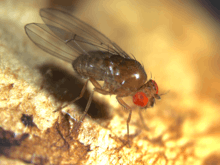 | |
| Drosophila innubila | |
| Scientific classification | |
| Kingdom: | |
| Phylum: | |
| Class: | |
| Order: | |
| Family: | |
| Subfamily: | |
| Genus: | |
| Subgenus: | |
| Species group: | Quinaria |
| Species[1][2] | |
| |
Mushroom-feeding ecology
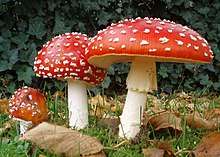
Quinaria group species are commonly found on wild mushrooms, and can metabolize toxic compounds in Amanita mushrooms,[3] such as ibotenic acid.[4] Mushroom sites also host a number of natural enemies. For instance, as a consequence of their mushroom-feeding ecology, Quinaria species are frequently infected by nematodes of the genus Howardula.[5] Some Quinaria species are more or less susceptible to nematode parasitization, though the immunological reasons remain unclear. One possibility to explain this variance is differences in defensive bacterial symbionts.[6]
The ancestor of Quinaria species and related flies likely switched from a generalist ecology to become exclusively mushroom-feeders. From there, different mushroom-feeding lineages emerged, some of which reverted to feeding on decaying vegetation,[7] such as Drosophila quinaria. Understanding the evolutionary forces that promoted a mushroom-feeding lifestyle, or reversion back to a more generalist ecology, can help understand concepts such as speciation and genetics of adaptation.
Quinaria group species such as Drosophila falleni are attracted to mushroom sites by cuing in on specific odourants that are common in rotting mushrooms, such as 1-pentanol, 1-octen-3-ol, and 3-methyl-1-butanol. Compared to Drosophila melanogaster, D. falleni are attracted to far more specific cues from rotting mushrooms. When D. falleni are infected by Howardula nematodes, infected flies become more averse to acetate-containing compounds such as ethyl acetate or propyl acetate. Conversely, infected flies become more attracted to 1-nonanol. This observation ties behavioural change to infection status, specifically identifying compounds that the fly becomes more or less averse to. Comparisons between mushroom-feeding Drosophila and D. melanogaster, and also between mushroom-specific Howardula parasitic nematodes and generalist nematodes could yield insight into how host-pathogen interactions alter olfactory preferences.[8]
Systematics
Evidence from phylogenetic studies suggests that the Quinaria group may be paraphyletic, comprising two clades. However, different phylogenetic analysis methods yield different results, so the exact systematics of the Quinaria group are still uncertain.[7][5][9]
Phylogeny
ASTRAL[10] phylogenetic cladogram topology from Scott Chialvo and colleagues (2019).[11]
| |||||||||||||||||||||||||||||||||||||||||||||||||||||||||||||||||||||||||||||||||||||||||||||||||||||||||||||||||||||||||||||||||||||||||||
| |||||||||||||||||||||||||||||||||||||||||||||||||||||||||||||||||||||||||||||||||||||||||||||||||||||||||||||||||||||||||||||||||||||||||||
Related species
Quinaria species are related to the Drosophila cardini, Drosophila bizonata, and Drosophila testacea species groups.[12] Evolutionary studies in these various mushroom-feeding Drosophila have contributed to understanding how symbiotic bacteria can drastically affect host evolution,[13] the impact of various genetic elements in natural populations,[14][15] and speciation.[16][17]
Genetics and genomics
Various Quinaria group species have contributed to genetic studies in different fashions. So far the genomes of two Quinaria species, D. guttifera and D. innubila, have been sequenced. Additional sequence data has been generated for Drosophila falleni and Drosophila phalerata. The genome of D. innubila was sequenced for a study in 2019, and boasts a very complete assembly rivalling that of the classic genetic model Drosophila melanogaster.[18]
Gene regulation on the fly
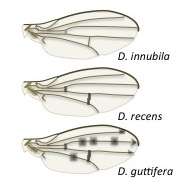
The patterning of Drosophila wings has long been of interest to evolutionary biologists as understanding the genetic changes underlying wing patterning helps understand how evolution can act to promote novel designs. Drosophila guttifera (the "Polka-dotted fruit fly") has conspicuous dot patterns on its wings made of black melanin. Different variations of these dot patterns occur in different Quinaria group species, ranging from no spots on the wings in D. innubila, to wing bands in D. recens, to conspicuous polka-dots in D. guttifera. One method to study these patterns has been to compare gene regulation amongst different Drosophila species.
The Drosophila Wnt signalling pathway regulates wing development. In the Wnt pathway, the Wingless gene encodes a ligand involved in the local development of melanin synthesis in the wing.[19] Other genes in the Wnt signalling pathway such as yellow and ebony are also involved in melanin regulation. Studies in the major genetic model organism Drosophila melanogaster are how the Wnt signalling pathway was first suspected. These studies implicated genes such as Wingless in wing development through mutations in Wnt signalling and the Wingless gene. Following this, studies in different species such as Drosophila biarmipes and Drosophila guttifera revealed different patterns of yellow gene expression.[20] As a result of these comparative studies, and owing to its attractive wing patterning, D. guttifera is now used as a comparative model to understand gene network interactions amongst Wingless, yellow, and other Wnt signalling genes. Understanding how these networks cooperate to regulate wing patterning also helps scientists understand how gene regulatory networks work in other systems such as health or development. Using conspicuous patterns like polka dot distribution on wings makes understanding general principles of gene regulation more approachable.
In 2015, the genome of Drosophila guttifera was sequenced by the laboratory of Sean B. Carroll providing an answer on how different wing patterns emerge in this species. The authors found that additional copies of genetic switches called "enhancers" drives the polka-dot pattern on the wings of D. guttifera.[21] These enhancers were a subset of cis-regulatory elements. As such, new evolutionary patterns can arise without modifying the active gene, by instead modifying existing enhancer regions. This leads to different patterns of gene expression, in the case of D. guttifera, resulting in different patterning on its wings.[22]
Population genetics and speciation
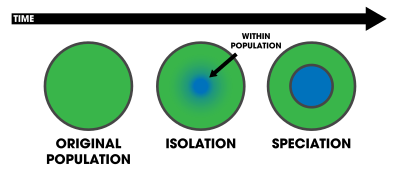
Speciation describes when two populations diverge sufficiently such that they are considered different species, often because they can no longer successfully reproduce with one another. This process is intuitive for conspicuous examples such as ring species, wherein a population splits due to a geographical barrier such as a mountain range, leading to allopatric populations. However why species diverge when their geographic ranges overlap (sympatric speciation) is less understood.
The sister species Drosophila subquinaria and Drosophila recens overlap in geographic range and are capable of hybridization, meaning they can successfully reproduce with each other;[16] however the offspring are very sickly. Thus, these two species are almost fully reproductively isolated, despite overlapping in geographic range. One reason for this is behavioural, driven by pheromones. D. subquinaria females readily avoid mating with males from other species, but surprisingly D. subquinaria females also avoid mating with males from the same species in allopatric populations. However D. recens females do not distinguish between males from different populations. Pheromones in the cuticle of the males differ between geographic ranges of D. subquinaria, possibly explaining how females distinguish males from different populations.[23] The bacterial symbiont Wolbachia is common in populations of D. recens, and causes cytoplasmic incompatibility in crosses between D. recens males and D. subquinaria females.[24] This has led to D. subquinaria females in sympatry with Wolbachia-infected D. recens to be more choosy when making a mate choice, while D. subquinaria females that are not sympatric with D. recens do not make this distinction.[25]
The D. subquinaria species complex is made all the more challenging to interpret by continued gene flow between D. recens and D. subquinaria. Beyond these two species, Drosophila transversa is also capable of hybridization with both D. subquinaria and D. recens.[26] Ginsberg and colleagues[27] showed that the direction of gene flow is biased from D. recens into sympatric populations of D. subquinaria. This is likely due to increased one-directional mating success between D. recens females and D. subquinaria males in sympatry, but may also depend on the efficiency with which the D. recens X chromosome acts in a D. subquinaria genetic background.[27][28]
Much of the work characterizing subquinaria-recens speciation is built on a body of work initiated in the 1970s by John Jaenike and fellow researchers.[29][30]
Microbial Symbiosis
Symbiosis refers to the interactions amongst living organisms. These interactions can range from parasitism to mutual benefit. Often whether something should be considered a parasite or a beneficial symbiont is context-dependent. For instance, reproductive manipulators like Spiroplasma bacteria can kill their hosts sperm to benefit the symbiont at the cost of the host. But these same bacteria can defend the host against immune challenge by parasites.
Endosymbionts
Bacterial endosymbionts are bacteria that live inside host compartments like inside host cells or in the blood. Endosymbionts are widespread in insects. The bacterial symbiont Wolbachia infects anywhere from 20-70% of all insects, while Spiroplasma is found in ~10% of Drosophila. These endosymbionts can have a number of different consequences from cytoplasmic incompatibility, male-killing, feminization, or defensive symbiosis.[31][32]
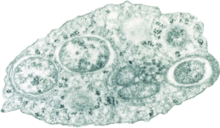
Wolbachia
Wolbachia is the most widespread of bacterial endosymbionts in insects and arthropods. Wolbachia bacteria are distant relatives of mitochondria, and like mitochondria, live inside host cells. Also like mitochondria, Wolbachia are inherited through females, so sons and daughters inherit Wolbachia almost exclusively from their mothers. Wolbachia are also commonly referred to as reproductive parasites. In different insects and arthropods, Wolbachia manipulate host reproduction to increase the number of females in the population. This benefits the Wolbachia as they are passed on from mothers to their offspring.[33]
Drosophila recens is commonly infected with a Wolbachia bacterial endosymbiont that causes cytoplasmic incompatibility. Females infected with this Wolbachia can readily mate with any male, regardless of the male's Wolbachia infection status. However uninfected females cannot mate with infected males. As such, Wolbachia infection in the population puts uninfected females at a mating disadvantage, as some proportion of their matings will not produce offspring. Moreover, the uninfected females invest resources into developing non-viable eggs, further reducing the reproductive fitness of uninfected females.[34] Wolbachia from Drosophila capable of cytoplasmic incompatibility are being explored for their potential to introduce laboratory-reared organisms for biocontrol, such as mosquitoes that do not transmit dengue virus, the causative agent of dengue fever.[35]
Drosophila innubila is a species commonly infected with a Wolbachia bacterial endosymbiont that causes male-killing. Male-killing results in the offspring of flies being entirely female, the biological sex with the higher reproductive output. Thus, while this reduces the number of viable eggs an infected female can produce, this Wolbachia spreads in the population owing to the increased reproductive output of females when compared to males. Female flies lay hundreds of eggs over their lifespan, and can store sperm in a specialized organ called the spermatheca. Thus, females do not need to mate repeatedly to successfully produce eggs. Meanwhile males first have to successfully mate with a female, and then also win battles against other males through sperm competition, which is a prominent example of sexual selection.[36]
Drosophila innubila is also commonly infected by the double-stranded DNA virus Drosophila innubila nudivirus (DiNV), the consequences of which are unknown.[37] It has been shown that certain Wolbachia can protect their hosts against viral infection, even leading to biocontrol strategies that use Wolbachia infection to suppress the spread of viral diseases.[38] What role (if any) Wolbachia plays in defence against DiNV is unclear.
Spiroplasma
Spiroplasma sp. are inherited bacterial symbionts that protect flies from parasites like wasps or nematodes.[39] So far, Spiroplasma has been recovered from one Quinaria group species, Drosophila tenebrosa. While Spiroplasma of Drosophila flies typically derive from the poulsonii or citri clades, the Spiroplasma of D. tenebrosa is highly divergent and currently classified in its own clade. While Spiroplasma of Drosophila melanogaster can also exhibit male-killing, the D. tenebrosa Spiroplasma did not.[40] It is possible that this Spiroplasma defends D. tenebrosa against parasites, as horizontal gene transfer of defensive genes amongst Spiroplasmas of mushroom-feeding flies has been observed, even amongst different Spiroplasma clades that infect very different groups of flies.[41]
The gut microbiome
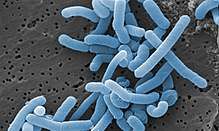
How animals select and shape their microbiota is of great interest to a number of research fields, particularly for the implications on human and animal health.[42] As a powerful model organism for genetics, the gut microbiome of D. melanogaster has been researched extensively. Common species in this microbiome include Lactobacillus plantarum and Acetobacter species, which are highly beneficial for the fly's development. Individuals lacking these bacterial associates develop slower, mature to a smaller size, and have reduced reproductive fitness. Secondary metabolites produced by these bacteria appear to be responsible for mediating these bacteria-host interactions, notably including lactate.[43][44] Lactate-producing bacteria are a core element of the human gut microbiome, and abundance of lactate is implicated in colonic disease. Additionally, lactate metabolism can lead to butyrate production in individuals with certain gut microbes such as Eubacterium; butyrate is associated with intestinal distress.[45] Lactobacillus sp. are also important bacteria in human development for milk digestion in infants, and are used as probiotics to help re-establish the microbiome in individuals following antibiotic treatment.[46] Core components of the innate immune system are common amongst all animals, from humans to fruit flies, and innate immunity is central to mediating interactions of the host and its gut microbes.[47] Understanding the biochemical basis of how metabolites (e.g. lactate) stimulate healthy development helps develop probiotic therapies aiming to improve gut health, particularly after the microbiome has been perturbed following illness and antibiotic treatments.[48]
Despite the many benefits of microbial colonization in D. melanogaster, its gut microbiome requires replenishment from the environment, as the microbiome is lost over time in sterile conditions.[49] Thus, D. melanogaster acquires its gut microbes from its food, a form of facultative symbiosis. However a recent report suggests some species of these bacteria can stably colonize the gut in wild populations.[50] Comparisons amongst Drosophila have been used to determine if core components of the microbiome are common amongst different species with very different food resources and life histories; the idea being that if core bacteria are common to all Drosophila species despite totally different ecologies, that would imply that the gut microbiome is an important component of development, and that evolution selects on the host and its microbiome collectively as a single unit, often referred to as the "holobiont." The existence of a "holobiont" level of selection acting on facultative symbionts is a controversial topic amongst evolutionary biologists, as the relationships between the host and these facultative symbionts is unstable and the two sides face distinct selective pressures. Globally this is thought to lead to largely independent evolution of the host from its facultative gut symbionts.[51]
No bacterial species are common amongst 100% of Drosophila species, though four major species represent 85% of the gut microbiome of all Drosophila screened so far.[52][53] While most Quinaria species feed on rotting mushrooms rife with bacteria, the gut microbiome of these mushroom-feeding flies differs drastically in composition from the bacterial communities on the mushrooms they visit. This suggests the host fly can selectively incorporate beneficial bacteria into its gut microbiome, and reject non-beneficial bacteria.[54] The mechanism behind how mushroom-feeding flies can selectively maintain their gut microbiota despite feeding on rotting mushroom is still unclear. Comparisons between the associations of other Drosophila and Quinaria group species may yield insight into both the host and bacterial mechanisms necessary for establishing a stable bacterial community.
Immunity
Mushroom-feeding Drosophila are commonly infested by nematodes and parasitic wasps. These pose important challenges for the host immune system with significant impacts on fitness and fertility.[5]
Parasitic infection
Many Quinaria group species are infected by parasitic nematodes of the genus Howardula,[5] especially Howardula aoronymphium. Infection by these nematodes can sterilize flies, or alter their olfactory preferences.[55] Some Quinaria group species are more or less susceptible to different nematode parasites. For instance, D. falleni and D. neotestacea are sterilized by Howardula aoronymphium nematodes, while related species resist infection.[5] This sterilization is associated with reduced expression of genes involved in egg development, and increases in cuticle synthesis pathways.[56] Mushroom-feeding Drosophila are used as a model for understanding the genetic basis of nematode susceptibility or resistance, which may lead to a better understanding of how the innate immune system responds to nematode parasites. Of note, while Drosophila melanogaster has an extremely well-characterized immune system and boasts powerful genetic tools, no nematode parasite naturally infects D. melanogaster. This has hampered the use of Drosophila as a model for interactions between nematodes and the innate immune system.[56][57]
Mushroom-feeding Drosophila are also frequently parasitized by parasitoid wasps such as Leptopilina sp.. These wasps infest the fly larva by inserting their ovipositor into the larva and depositing an egg internally. The wasp larvae hatch within the host, and remain relatively benign until fly pupation. This is because the wasp larva requires the fly larva to develop to the point of pupation so the wasp itself can metamorphose within the puparium in place of the fly. This process ultimately kills the fly, which is devoured by the developing wasp. Parasitic wasps also frequently inject toxins or even virus-like particles alongside their eggs that suppress the host immune response to increase the success of the wasp larva.[58][59] In response, the fly immune system attempts to encapsulate invading wasp larva and attacks them using the insect melanization response. In D. melanogaster, specialized blood cells called lamellocytes that regulate local melanin synthesis during capsule formation.[60] However these blood cells are absent in other Drosophila species.[61] Despite this, these other Drosophila can nonetheless suppress wasp development through unknown immune mechanisms, though susceptibility varies by species of fly and species of wasp. In some species, the bacterial symbiont Spiroplasma protects related mushroom-feeding Drosophila from wasp parasitization using toxins that selectively kill the wasp larva but not the host fly, an interaction well-characterized using comparisons between Spiroplasma from D. melanogaster and the mushroom-feeding Drosophila neotestacea.[62]
Different mite parasites are also common at mushroom sites. Mites are external parasites that latch onto the fly abdomen and feed on the hemolymph. Mite bites or parasitic wasp stings are a natural mechanism to introduce infections. They may also serve as a mechanism to introduce and distribute bacterial endosymbionts between different fly species.[63]
Immune response
The genome of D. innubila was sequenced in 2019, and highlighted the importance of the interaction between D. innubila and its viruses as implied by patterns of immune evolution in antiviral genes. Notably, natural selection on the immunity and antiviral pathways in D. innubila differ markedly from D. melanogaster, implying divergent evolutionary pressures.[18] The DiNV DNA virus is similar to the D. melanogaster Kallithea virus.[64] As such, comparisons between D. melanogaster and D. innubila and their viruses promise to inform on the nature of host-virus interactions.[18]
The antimicrobial peptide gene Diptericin B has been pseudogenized in two independent lineages of mushroom-feeding fruit flies: the Quinaria group species Drosophila guttifera and the more distantly related Drosophila neotestacea.[65] Diptericin B is conserved in all other Drosophila species, yet these two pseudogenization events in mushroom-breeding flies were independent, suggesting Diptericin B is actively lost in these species. However Diptericin B is retained in Drosophila innubila, and remains transcriptionally active. It also seems that unrelated Tephritid fruit flies have independently derived a Diptericin gene strikingly similar to the Drosophila Diptericin B gene. These evolutionary patterns in mushroom-breeding Drosophila and other fruit flies suggests that the immune system's effectors (like antimicrobial peptides) are directly shaped by host ecology.[66]
Diptericins are important immune molecules in defence against Providencia bacteria,[67][68] and Diptericin B has also been shown to affect memory formation in Drosophila melanogaster.[69] The loss of Diptericin B in these mushroom-breeding flies implies that this immune molecule is unimportant for the ecology of mushroom-feeding flies, but somehow important for other fruit flies in the genus Drosophila.[66]
See also
References
- "FlyBase Archive Warning". fb2014_03.flybase.org. Retrieved 2019-04-18.
- Markow TA, O'Grady P (2005). Drosophila: A Guide to Species Identification and Use. Elsevier. ISBN 978-0-08-045409-2.
- Jaenike, John (1978). "Host Selection by Mycophagous Drosophila". Ecology. 59 (6): 1286–1288. doi:10.2307/1938245. JSTOR 1938245.
- Tuno N, Takahashi KH, Yamashita H, Osawa N, Tanaka C (February 2007). "Tolerance of Drosophila flies to ibotenic acid poisons in mushrooms". Journal of Chemical Ecology. 33 (2): 311–7. doi:10.1007/s10886-006-9228-3. PMID 17195114.
- Perlman SJ, Jaenike J (March 2003). "Infection success in novel hosts: an experimental and phylogenetic study of Drosophila-parasitic nematodes". Evolution; International Journal of Organic Evolution. 57 (3): 544–57. doi:10.1111/j.0014-3820.2003.tb01546.x. PMID 12703944.
- Jaenike J, Unckless R, Cockburn SN, Boelio LM, Perlman SJ (July 2010). "Adaptation via symbiosis: recent spread of a Drosophila defensive symbiont". Science. 329 (5988): 212–5. Bibcode:2010Sci...329..212J. doi:10.1126/science.1188235. PMID 20616278.
- Scott Chialvo CH, White BE, Reed LK, Dyer KA (January 2019). "A phylogenetic examination of host use evolution in the quinaria and testacea groups of Drosophila". Molecular Phylogenetics and Evolution. 130: 233–243. doi:10.1016/j.ympev.2018.10.027. PMC 6327841. PMID 30366088.
- Cevallos JA, Okubo RP, Perlman SJ, Hallem EA (April 2017). "Olfactory Preferences of the Parasitic Nematode Howardula aoronymphium and its Insect Host Drosophila falleni". Journal of Chemical Ecology. 43 (4): 362–373. doi:10.1007/s10886-017-0834-z. PMC 5673469. PMID 28315996.
- Izumitani HF, Kusaka Y, Koshikawa S, Toda MJ, Katoh T (27 July 2016). "Phylogeography of the Subgenus Drosophila (Diptera: Drosophilidae): Evolutionary History of Faunal Divergence between the Old and the New Worlds". PLOS ONE. 11 (7): e0160051. Bibcode:2016PLoSO..1160051I. doi:10.1371/journal.pone.0160051. PMC 4962979. PMID 27462734.
- Zhang C, Rabiee M, Sayyari E, Mirarab S (May 2018). "ASTRAL-III: polynomial time species tree reconstruction from partially resolved gene trees". BMC Bioinformatics. 19 (Suppl 6): 153. doi:10.1186/s12859-018-2129-y. PMC 5998893. PMID 29745866.
- Scott Chialvo CH, White BE, Reed LK, Dyer KA (January 2019). "A phylogenetic examination of host use evolution in the quinaria and testacea groups of Drosophila". Molecular Phylogenetics and Evolution. 130: 233–243. doi:10.1016/j.ympev.2018.10.027. PMC 6327841. PMID 30366088.
- Scott Chialvo CH, White BE, Reed LK, Dyer KA (January 2019). "A phylogenetic examination of host use evolution in the quinaria and testacea groups of Drosophila". Molecular Phylogenetics and Evolution. 130: 233–243. doi:10.1016/j.ympev.2018.10.027. PMC 6327841. PMID 30366088.
- Hamilton PT, Peng F, Boulanger MJ, Perlman SJ (January 2016). "A ribosome-inactivating protein in a Drosophila defensive symbiont". Proceedings of the National Academy of Sciences of the United States of America. 113 (2): 350–5. Bibcode:2016PNAS..113..350H. doi:10.1073/pnas.1518648113. PMC 4720295. PMID 26712000.
- Pinzone CA, Dyer KA (October 2013). "Association of polyandry and sex-ratio drive prevalence in natural populations of Drosophila neotestacea". Proceedings. Biological Sciences. 280 (1769): 20131397. doi:10.1098/rspb.2013.1397. PMC 3768301. PMID 24004936.
- Keais GL, Hanson MA, Gowen BE, Perlman SJ (June 2017). "X chromosome drive in a widespread Palearctic woodland fly, Drosophila testacea". Journal of Evolutionary Biology. 30 (6): 1185–1194. doi:10.1111/jeb.13089. PMID 28402000.
- Humphreys DP, Rundle HD, Dyer KA (April 2016). "Drosophila subquinaria complex: can reinforced premating isolation cascade to other species?". Current Zoology. 62 (2): 183–191. doi:10.1093/cz/zow005. PMC 5804228. PMID 29491905.
- Jaenike J, James AC, Grimaldi D (1 November 1992). "Systematics and Modes of Reproductive Isolation in the Holarctic Drosophila testacea Species Group (Diptera: Drosophilidae)". Annals of the Entomological Society of America. 85 (6): 671–685. doi:10.1093/aesa/85.6.671.
- Hill T, Koseva BS, Unckless RL (July 2019). "The Genome of Drosophila innubila Reveals Lineage-Specific Patterns of Selection in Immune Genes". Molecular Biology and Evolution. 36 (7): 1405–1417. doi:10.1093/molbev/msz059. PMC 6573480. PMID 30865231.
- Koshikawa S, Fukutomi Y, Matsumoto K (2017). "Drosophila guttifera as a Model System for Unraveling Color Pattern Formation". Diversity and Evolution of Butterfly Wing Patterns. pp. 287–301. doi:10.1007/978-981-10-4956-9_16. ISBN 978-981-10-4955-2.
- Gompel N, Prud'homme B, Wittkopp PJ, Kassner VA, Carroll SB (February 2005). "Chance caught on the wing: cis-regulatory evolution and the origin of pigment patterns in Drosophila". Nature. 433 (7025): 481–7. Bibcode:2005Natur.433..481G. doi:10.1038/nature03235. PMID 15690032.
- Koshikawa S, Giorgianni MW, Vaccaro K, Kassner VA, Yoder JH, Werner T, Carroll SB (June 2015). "Gain of cis-regulatory activities underlies novel domains of wingless gene expression in Drosophila". Proceedings of the National Academy of Sciences of the United States of America. 112 (24): 7524–9. Bibcode:2015PNAS..112.7524K. doi:10.1073/pnas.1509022112. PMC 4475944. PMID 26034272.
- Koshikawa S, Fukutomi Y, Matsumoto K (2017). "Drosophila guttifera as a Model System for Unraveling Color Pattern Formation". Diversity and Evolution of Butterfly Wing Patterns. pp. 287–301. doi:10.1007/978-981-10-4956-9_16. ISBN 978-981-10-4955-2.
- Humphreys DP, Rundle HD, Dyer KA (April 2016). "Drosophila subquinaria complex: can reinforced premating isolation cascade to other species?". Current Zoology. 62 (2): 183–191. doi:10.1093/cz/zow005. PMC 5804228. PMID 29491905.
- Jaenike J, Dyer KA, Cornish C, Minhas MS (October 2006). "Asymmetrical reinforcement and Wolbachia infection in Drosophila". PLoS Biology. 4 (10): e325. doi:10.1371/journal.pbio.0040325. PMC 1592313. PMID 17032063.
- Jaenike J, Dyer KA, Cornish C, Minhas MS (October 2006). "Asymmetrical reinforcement and Wolbachia infection in Drosophila". PLoS Biology. 4 (10): e325. doi:10.1371/journal.pbio.0040325. PMC 1592313. PMID 17032063.
- Shoemaker DD, Katju V, Jaenike J (August 1999). "Wolbachia and the Evolution of Reproductive Isolation Between Drosophila Recens and Drosophila Subquinaria". Evolution; International Journal of Organic Evolution. 53 (4): 1157–1164. doi:10.1111/j.1558-5646.1999.tb04529.x. PMID 28565520.
- Ginsberg PS, Humphreys DP, Dyer KA (October 2019). "Ongoing hybridization obscures phylogenetic relationships in the Drosophila subquinaria species complex". Journal of Evolutionary Biology. 32 (10): 1093–1105. doi:10.1111/jeb.13512. PMC 6783338. PMID 31385638.
- Dyer KA, Bewick ER, White BE, Bray MJ, Humphreys DP (August 2018). "Fine-scale geographic patterns of gene flow and reproductive character displacement in Drosophila subquinaria and Drosophila recens". Molecular Ecology. 27 (18): 3655–3670. doi:10.1111/mec.14825. PMC 6360132. PMID 30074656.
- "FlyTree - John Jaenike Family Tree". academictree.org. Retrieved 2019-04-18.
- Jaenike J (September 1978). "Resource Predictability and Niche Breadth in the Drosophila quinaria Species Group". Evolution; International Journal of Organic Evolution. 32 (3): 676–678. doi:10.1111/J.1558-5646.1978.TB04613.X. JSTOR 2407734. PMID 28567956.
- Hilgenboecker K, Hammerstein P, Schlattmann P, Telschow A, Werren JH (April 2008). "How many species are infected with Wolbachia?--A statistical analysis of current data". FEMS Microbiology Letters. 281 (2): 215–20. doi:10.1111/j.1574-6968.2008.01110.x. PMC 2327208. PMID 18312577.
- Hamilton PT, Perlman SJ (26 December 2013). "Host defense via symbiosis in Drosophila". PLoS Pathogens. 9 (12): e1003808. doi:10.1371/journal.ppat.1003808. PMC 3873448. PMID 24385901.
- Bowman DD (November 2011). "Introduction to the alpha-proteobacteria: Wolbachia and Bartonella, Rickettsia, Brucella, Ehrlichia, and Anaplasma". Topics in Companion Animal Medicine. 26 (4): 173–7. doi:10.1053/j.tcam.2011.09.002. PMID 22152604.
- Humphreys DP, Rundle HD, Dyer KA (April 2016). "Drosophila subquinaria complex: can reinforced premating isolation cascade to other species?". Current Zoology. 62 (2): 183–191. doi:10.1093/cz/zow005. PMC 5804228. PMID 29491905.
- Callaway, Ewen (8 August 2018). "Dengue rates plummet in Australian city after release of modified mosquitoes". Nature. doi:10.1038/d41586-018-05914-3.
- https://www.sas.rochester.edu/bio/people/faculty/jaenike_john/
- Hill T, Unckless RL (January 2018). "The dynamic evolution of Drosophila innubila Nudivirus". Infection, Genetics and Evolution. 57: 151–157. doi:10.1016/j.meegid.2017.11.013. PMC 5725240. PMID 29155284.
- Hoffmann AA, Montgomery BL, Popovici J, Iturbe-Ormaetxe I, Johnson PH, Muzzi F, et al. (August 2011). "Successful establishment of Wolbachia in Aedes populations to suppress dengue transmission". Nature. 476 (7361): 454–7. Bibcode:2011Natur.476..454H. doi:10.1038/nature10356. PMID 21866160.
- Haselkorn TS, Jaenike J (July 2015). "Macroevolutionary persistence of heritable endosymbionts: acquisition, retention and expression of adaptive phenotypes in Spiroplasma". Molecular Ecology. 24 (14): 3752–65. doi:10.1111/mec.13261. PMID 26053523.
- Watts T, Haselkorn TS, Moran NA, Markow TA (May 2009). "Variable incidence of Spiroplasma infections in natural populations of Drosophila species". PLOS ONE. 4 (5): e5703. Bibcode:2009PLoSO...4.5703W. doi:10.1371/journal.pone.0005703. PMC 2683927. PMID 19492088.
- Ballinger MJ, Gawryluk RM, Perlman SJ (January 2019). "Toxin and Genome Evolution in a Drosophila Defensive Symbiosis". Genome Biology and Evolution. 11 (1): 253–262. doi:10.1093/gbe/evy272. PMC 6349354. PMID 30576446.
- Mohajeri MH, Brummer RJ, Rastall RA, Weersma RK, Harmsen HJ, Faas M, Eggersdorfer M (May 2018). "The role of the microbiome for human health: from basic science to clinical applications". European Journal of Nutrition. 57 (Suppl 1): 1–14. doi:10.1007/s00394-018-1703-4. PMC 5962619. PMID 29748817.
- Storelli G, Defaye A, Erkosar B, Hols P, Royet J, Leulier F (September 2011). "Lactobacillus plantarum promotes Drosophila systemic growth by modulating hormonal signals through TOR-dependent nutrient sensing". Cell Metabolism. 14 (3): 403–14. doi:10.1016/j.cmet.2011.07.012. PMID 21907145.
- Iatsenko I, Boquete JP, Lemaitre B (November 2018). "Microbiota-Derived Lactate Activates Production of Reactive Oxygen Species by the Intestinal NADPH Oxidase Nox and Shortens Drosophila Lifespan". Immunity. 49 (5): 929–942.e5. doi:10.1016/j.immuni.2018.09.017. PMID 30446385.
- Duncan SH, Louis P, Flint HJ (October 2004). "Lactate-utilizing bacteria, isolated from human feces, that produce butyrate as a major fermentation product". Applied and Environmental Microbiology. 70 (10): 5810–7. doi:10.1128/AEM.70.10.5810-5817.2004. PMC 522113. PMID 15466518.
- Selle K, Klaenhammer TR (November 2013). "Genomic and phenotypic evidence for probiotic influences of Lactobacillus gasseri on human health". FEMS Microbiology Reviews. 37 (6): 915–35. doi:10.1111/1574-6976.12021. PMID 23488471.
- Iatsenko I, Boquete JP, Lemaitre B (November 2018). "Microbiota-Derived Lactate Activates Production of Reactive Oxygen Species by the Intestinal NADPH Oxidase Nox and Shortens Drosophila Lifespan". Immunity. 49 (5): 929–942.e5. doi:10.1016/j.immuni.2018.09.017. PMID 30446385.
- Stanton C, Ross RP, Fitzgerald GF, Van Sinderen D (April 2005). "Fermented functional foods based on probiotics and their biogenic metabolites". Current Opinion in Biotechnology. 16 (2): 198–203. doi:10.1016/j.copbio.2005.02.008. PMID 15831387.
- Blum JE, Fischer CN, Miles J, Handelsman J (November 2013). "Frequent replenishment sustains the beneficial microbiome of Drosophila melanogaster". mBio. 4 (6): e00860-13. doi:10.1128/mBio.00860-13. PMC 3892787. PMID 24194543.
- Pais IS, Valente RS, Sporniak M, Teixeira L (July 2018). "Drosophila melanogaster establishes a species-specific mutualistic interaction with stable gut-colonizing bacteria". PLoS Biology. 16 (7): e2005710. doi:10.1371/journal.pbio.2005710. PMC 6049943. PMID 29975680.
- Moran NA, Sloan DB (December 2015). "The Hologenome Concept: Helpful or Hollow?". PLoS Biology. 13 (12): e1002311. doi:10.1371/journal.pbio.1002311. PMC 4670207. PMID 26636661.
- Wong AC, Chaston JM, Douglas AE (October 2013). "The inconstant gut microbiota of Drosophila species revealed by 16S rRNA gene analysis". The ISME Journal. 7 (10): 1922–32. doi:10.1038/ismej.2013.86. PMC 3965314. PMID 23719154.
- Pais IS, Valente RS, Sporniak M, Teixeira L (July 2018). "Drosophila melanogaster establishes a species-specific mutualistic interaction with stable gut-colonizing bacteria". PLoS Biology. 16 (7): e2005710. doi:10.1371/journal.pbio.2005710. PMC 6049943. PMID 29975680.
- Martinson VG, Douglas AE, Jaenike J (May 2017). "Community structure of the gut microbiota in sympatric species of wild Drosophila". Ecology Letters. 20 (5): 629–639. doi:10.1111/ele.12761. PMID 28371064.
- Cevallos JA, Okubo RP, Perlman SJ, Hallem EA (April 2017). "Olfactory Preferences of the Parasitic Nematode Howardula aoronymphium and its Insect Host Drosophila falleni". Journal of Chemical Ecology. 43 (4): 362–373. doi:10.1007/s10886-017-0834-z. PMC 5673469. PMID 28315996.
- Hamilton PT, Leong JS, Koop BF, Perlman SJ (March 2014). "Transcriptional responses in a Drosophila defensive symbiosis" (PDF). Molecular Ecology. 23 (6): 1558–70. doi:10.1111/mec.12603. hdl:1828/8389. PMID 24274471.
- Eleftherianos I, Castillo JC, Patrnogic J (December 2016). "TGF-β signaling regulates resistance to parasitic nematode infection in Drosophila melanogaster". Immunobiology. 221 (12): 1362–1368. doi:10.1016/j.imbio.2016.07.011. PMC 5075508. PMID 27473342.
- Colinet D, Dubuffet A, Cazes D, Moreau S, Drezen JM, Poirié M (May 2009). "A serpin from the parasitoid wasp Leptopilina boulardi targets the Drosophila phenoloxidase cascade". Developmental and Comparative Immunology. 33 (5): 681–9. doi:10.1016/j.dci.2008.11.013. PMID 19109990.
- Chiu H, Morales J, Govind S (February 2006). "Identification and immuno-electron microscopy localization of p40, a protein component of immunosuppressive virus-like particles from Leptopilina heterotoma, a virulent parasitoid wasp of Drosophila". The Journal of General Virology. 87 (Pt 2): 461–70. doi:10.1099/vir.0.81474-0. PMC 2705942. PMID 16432035.
- Dudzic JP, Kondo S, Ueda R, Bergman CM, Lemaitre B (October 2015). "Drosophila innate immunity: regional and functional specialization of prophenoloxidases". BMC Biology. 13 (1): 81. doi:10.1186/s12915-015-0193-6. PMC 4595066. PMID 26437768.
- Salazar-Jaramillo L, Paspati A, van de Zande L, Vermeulen CJ, Schwander T, Wertheim B (February 2014). "Evolution of a cellular immune response in Drosophila: a phenotypic and genomic comparative analysis". Genome Biology and Evolution. 6 (2): 273–89. doi:10.1093/gbe/evu012. PMC 3942026. PMID 24443439.
- Ballinger MJ, Perlman SJ (July 2017). "Generality of toxins in defensive symbiosis: Ribosome-inactivating proteins and defense against parasitic wasps in Drosophila". PLoS Pathogens. 13 (7): e1006431. doi:10.1371/journal.ppat.1006431. PMC 5500355. PMID 28683136.
- Gehrer L, Vorburger C (August 2012). "Parasitoids as vectors of facultative bacterial endosymbionts in aphids". Biology Letters. 8 (4): 613–5. doi:10.1098/rsbl.2012.0144. PMC 3391472. PMID 22417790.
- Webster CL, Waldron FM, Robertson S, Crowson D, Ferrari G, Quintana JF, et al. (July 2015). "The Discovery, Distribution, and Evolution of Viruses Associated with Drosophila melanogaster". PLoS Biology. 13 (7): e1002210. doi:10.1371/journal.pbio.1002210. PMC 4501690. PMID 26172158.
- Hanson MA, Hamilton PT, Perlman SJ (October 2016). "Immune genes and divergent antimicrobial peptides in flies of the subgenus Drosophila". BMC Evolutionary Biology. 16 (1): 228. doi:10.1186/s12862-016-0805-y. PMC 5078906. PMID 27776480.
- Hanson, Mark Austin; Lemaitre, Bruno; Unckless, Robert L. (2019). "Dynamic evolution of antimicrobial peptides underscores trade-offs between immunity and ecological fitness". Frontiers in Immunology. 10: 2620. doi:10.3389/fimmu.2019.02620. ISSN 1664-3224. PMC 6857651. PMID 31781114.
- Unckless RL, Howick VM, Lazzaro BP (January 2016). "Convergent Balancing Selection on an Antimicrobial Peptide in Drosophila". Current Biology. 26 (2): 257–262. doi:10.1016/j.cub.2015.11.063. PMC 4729654. PMID 26776733.
- Hanson MA, Dostálová A, Ceroni C, Poidevin M, Kondo S, Lemaitre B (February 2019). "Synergy and remarkable specificity of antimicrobial peptides in vivo using a systematic knockout approach". eLife. 8. doi:10.7554/eLife.44341. PMC 6398976. PMID 30803481.
- Barajas-Azpeleta R, Wu J, Gill J, Welte R, Seidel C, McKinney S, et al. (October 2018). "Antimicrobial peptides modulate long-term memory". PLoS Genetics. 14 (10): e1007440. doi:10.1371/journal.pgen.1007440. PMC 6224176. PMID 30312294.